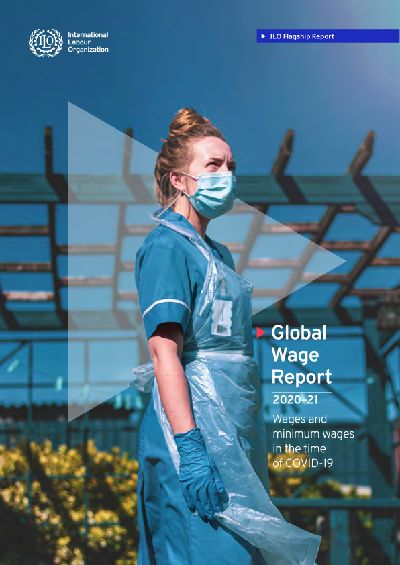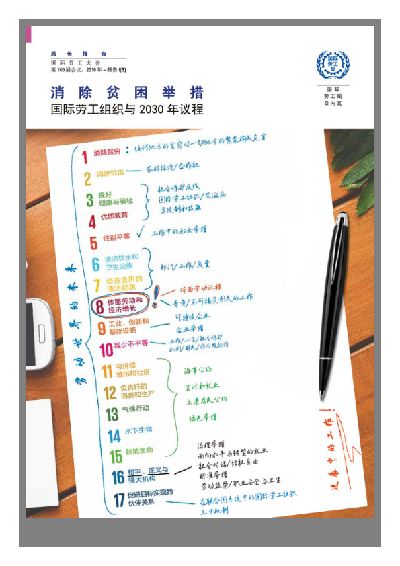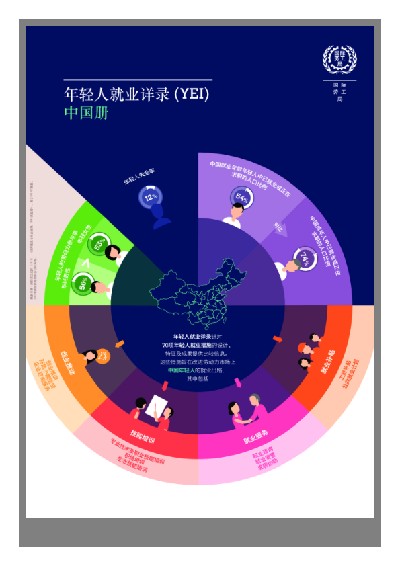"ILO"相关数据
更新时间:2021-12-312021年世界就业和社会展望
Technological innovation is transforming every part of our lives. The ability toquickly and cheaply exchange large amounts of data and information has laid thefoundations for the rise of the digital economy and digital labour platforms.In bothdeveloped and developing countries businesses and consumers have embracedthis transformation, as services and goods are delivered in ways that are cheaperand more convenient.Digitallabour platforms are now part of our everyday lives.This transformation extends to the world of work. Digital labour platforms offer newmarkets for businesses and more income-generating opportunities for workers,including those who were previously outside the labour market.Such platforms areleading to changes not just to the organization of enterprises and work processesbut in many cases to the relationship between workers and businesses as well.lt is widely considered that the cOvID-19 pandemic has accelerated changes thatwere already under way, both in society and at work.These include the expanded useof digital platforms and related technological innovations like cloud computing andthe use of big data and algorithms.The result has been innovative ways of working,and flexibility for both workers and businesses. The remote working arrangementsadopted by many during the past year have brought a rise in e-commerce, e-servicesand online freelance work.For many who lost their jobs, in both developing and de-veloped countries, digital labour platforms have offered opportunities to earn someincome.Many businesses have relied on digitallabour platforms to keep operating,reach new markets and reduce costs.
But there are challenges.This new business model allows platforms to organize workwithout having to invest in capital assets or to hire employees.Instead, they mediatebetween the workers who perform the tasks and clients,and manage the entirework process with algorithms. Workers on digital labour platforms often struggle tofind sufficient well-paid work to earn a decentincome, creating a danger of workingpoverty. Many do not have access to social protection, which is particularly con-cerning during a pandemic. They are frequently unable to engage in the collectivebargaining that would allow them to have these and other issues addressed.
【更多详情,请下载:2021年世界就业和社会展望】

 1970-2016年全球194个国家和地区女性在服务业就业的比例请参阅ILOSTAT提供的概念和方法,网址为http:∕∕www.ilo.org∕ilostat∕faces∕ilostat-home∕metadata1970-2016年发布时间:2020-07-01
1970-2016年全球194个国家和地区女性在服务业就业的比例请参阅ILOSTAT提供的概念和方法,网址为http:∕∕www.ilo.org∕ilostat∕faces∕ilostat-home∕metadata1970-2016年发布时间:2020-07-01 1970-2016年全球195个国家和地区女性在工业中的就业比例请参阅ILOSTAT提供的概念和方法,网址为http:∕∕www.ilo.org∕ilostat∕faces∕ilostat-home∕metadata1970-2016年发布时间:2020-07-01
1970-2016年全球195个国家和地区女性在工业中的就业比例请参阅ILOSTAT提供的概念和方法,网址为http:∕∕www.ilo.org∕ilostat∕faces∕ilostat-home∕metadata1970-2016年发布时间:2020-07-01 1970-2016年全球193个国家和地区女性在农业中的就业比例请参阅ILOSTAT提供的概念和方法,网址为http:∕∕www.ilo.org∕ilostat∕faces∕ilostat-home∕metadata1970-2016年发布时间:2020-07-01
1970-2016年全球193个国家和地区女性在农业中的就业比例请参阅ILOSTAT提供的概念和方法,网址为http:∕∕www.ilo.org∕ilostat∕faces∕ilostat-home∕metadata1970-2016年发布时间:2020-07-01 1990-2016年全球60个国家和地区基于购买力平价的女性雇员的平均小时收入(按2011年不变价美元)请参阅ILOSTAT提供的概念和方法,网址为http:∕∕www.ilo.org∕ilostat∕faces∕ilostat-home∕metadata1990-2016年发布时间:2020-06-12
1990-2016年全球60个国家和地区基于购买力平价的女性雇员的平均小时收入(按2011年不变价美元)请参阅ILOSTAT提供的概念和方法,网址为http:∕∕www.ilo.org∕ilostat∕faces∕ilostat-home∕metadata1990-2016年发布时间:2020-06-12 1990-2016年全球60个国家和地区基于购买力平价的男性雇员的平均小时收入(按2011年不变价美元)请参阅ILOSTAT提供的概念和方法,网址为http:∕∕www.ilo.org∕ilostat∕faces∕ilostat-home∕metadata1990-2016年发布时间:2020-06-12
1990-2016年全球60个国家和地区基于购买力平价的男性雇员的平均小时收入(按2011年不变价美元)请参阅ILOSTAT提供的概念和方法,网址为http:∕∕www.ilo.org∕ilostat∕faces∕ilostat-home∕metadata1990-2016年发布时间:2020-06-12 1990-2016年全球59个国家基于购买力平价的雇员的平均小时收入(按2011年不变价美元)请参阅ILOSTAT提供的概念和方法,网址为http:∕∕www.ilo.org∕ilostat∕faces∕ilostat-home∕metadata1990-2016年发布时间:2020-06-12
1990-2016年全球59个国家基于购买力平价的雇员的平均小时收入(按2011年不变价美元)请参阅ILOSTAT提供的概念和方法,网址为http:∕∕www.ilo.org∕ilostat∕faces∕ilostat-home∕metadata1990-2016年发布时间:2020-06-12 1995-2015年全球29个国家低收入者的女性比例在所有低薪工人中,低薪工人中女性所占的百分比是低薪工人中女性所占的百分比。 如果工人在所有工作岗位上的时薪少于时薪中位数的三分之二,则被视为“低薪”。 有关更多详细信息,请参见ILOSTAT提供的概念和方法,网址为http:∕∕www.ilo.org∕ilostat∕faces∕ilostat-home∕metadata1995-2015年发布时间:2020-07-01
1995-2015年全球29个国家低收入者的女性比例在所有低薪工人中,低薪工人中女性所占的百分比是低薪工人中女性所占的百分比。 如果工人在所有工作岗位上的时薪少于时薪中位数的三分之二,则被视为“低薪”。 有关更多详细信息,请参见ILOSTAT提供的概念和方法,网址为http:∕∕www.ilo.org∕ilostat∕faces∕ilostat-home∕metadata1995-2015年发布时间:2020-07-01 2021年世界就业和社会展望国际劳工组织今天发布的《2021年世界就业和社会展望》报告指出,过去十年来,全球范围内的数字化劳动力平台增长了五倍。 报告指出,这种增长突显了进行国际政策对话和监管合作的必要性,以便提供体面的工作机会,并更可持续地促进企业的增长。 报告指出,数字化劳动力平台正在提供新的工作机会,包括为妇女、残疾人、年轻人和在传统劳动力市场中被边缘化的人。平台还允许企业灵活地接触具有各种技能的庞大的劳工群体,同时扩大客户群。 报告重点介绍了两种主要类型的数字化劳动力平台:基于在线网络的平台,工作任务由工人在线和远程执行;以及基于指定位置的平台,任务由个人在指定位置完成,例如出租车司机和送货工人。 报告基于对世界各地多个部门的约1万2000名工人和来自85个企业的代表进行的调查和采访而得出结论。2021年发布时间:2021-03-03
2021年世界就业和社会展望国际劳工组织今天发布的《2021年世界就业和社会展望》报告指出,过去十年来,全球范围内的数字化劳动力平台增长了五倍。 报告指出,这种增长突显了进行国际政策对话和监管合作的必要性,以便提供体面的工作机会,并更可持续地促进企业的增长。 报告指出,数字化劳动力平台正在提供新的工作机会,包括为妇女、残疾人、年轻人和在传统劳动力市场中被边缘化的人。平台还允许企业灵活地接触具有各种技能的庞大的劳工群体,同时扩大客户群。 报告重点介绍了两种主要类型的数字化劳动力平台:基于在线网络的平台,工作任务由工人在线和远程执行;以及基于指定位置的平台,任务由个人在指定位置完成,例如出租车司机和送货工人。 报告基于对世界各地多个部门的约1万2000名工人和来自85个企业的代表进行的调查和采访而得出结论。2021年发布时间:2021-03-03 2020-2021年全球工资报告2020年前6个月,由于正处于疫情高峰期间,全球月工资水平呈下降和较慢增长态势。未来一段时期,疫情带来的巨大工资下行压力将持续存在。在那些采取了强有力就业保障措施的国家,疫情对经济的影响主要表现为工资下降,而不是大量失业。疫情对不同群体的工资影响是不均等的,对女性的影响比男性更严重,对低收入工人和低技能职业者造成的损失大于高薪管理人员和专业职位工作者。2020-2021年发布时间:2021-01-15
2020-2021年全球工资报告2020年前6个月,由于正处于疫情高峰期间,全球月工资水平呈下降和较慢增长态势。未来一段时期,疫情带来的巨大工资下行压力将持续存在。在那些采取了强有力就业保障措施的国家,疫情对经济的影响主要表现为工资下降,而不是大量失业。疫情对不同群体的工资影响是不均等的,对女性的影响比男性更严重,对低收入工人和低技能职业者造成的损失大于高薪管理人员和专业职位工作者。2020-2021年发布时间:2021-01-15 消除贫困举措-国际劳工组织与2030年议程2015年9月,全世界在联合国大会上齐聚一堂,通过了《2030年可持续发展议程》,决心“在现在到2030年的这一段时间内,在世界各地消除贫困与饥饿;消除各个国家内和各个国家之间的不平等;建立和平公正和包容的社会﹔保护人权和促进性别平等并为妇女和女童赋权;永久保护地球及其自然资源”,还决心“创造条件,实现可持续、包容和持久的经济增长,让所有人分享繁荣并拥有体面劳动,同时顾及各国不同的发展水平和能力。”2030年发布时间:2020-09-24
消除贫困举措-国际劳工组织与2030年议程2015年9月,全世界在联合国大会上齐聚一堂,通过了《2030年可持续发展议程》,决心“在现在到2030年的这一段时间内,在世界各地消除贫困与饥饿;消除各个国家内和各个国家之间的不平等;建立和平公正和包容的社会﹔保护人权和促进性别平等并为妇女和女童赋权;永久保护地球及其自然资源”,还决心“创造条件,实现可持续、包容和持久的经济增长,让所有人分享繁荣并拥有体面劳动,同时顾及各国不同的发展水平和能力。”2030年发布时间:2020-09-24 年轻人就业详录-中国册本文旨在收集世界各地有关年轻人就业措施的信息及实证,是首套专门就年轻人就业措施的设计、执行与有效性提供比较信息的综合信息库,从而了解近来的就业措施趋势,这些措施包括技能培训、创业推动、就业服务和就业补贴——它们或被独立施行,或与其他措施结合施行。 除了每项措施的地理覆盖范围、规模和目标人群特征以外,本手册还补充说明了各措施的设计、成本、具体执行和筹资机制。 另外,年轻人就业详录 (YEI) 还收录了年轻人就业措施的追踪与评估结果,以便更好地了解其有效性。2016年发布时间:2020-08-11
年轻人就业详录-中国册本文旨在收集世界各地有关年轻人就业措施的信息及实证,是首套专门就年轻人就业措施的设计、执行与有效性提供比较信息的综合信息库,从而了解近来的就业措施趋势,这些措施包括技能培训、创业推动、就业服务和就业补贴——它们或被独立施行,或与其他措施结合施行。 除了每项措施的地理覆盖范围、规模和目标人群特征以外,本手册还补充说明了各措施的设计、成本、具体执行和筹资机制。 另外,年轻人就业详录 (YEI) 还收录了年轻人就业措施的追踪与评估结果,以便更好地了解其有效性。2016年发布时间:2020-08-11 1991-2017年全球272个国家和地区国际劳工组织模型估算的女性失业率该数据包含了1991-2017年全球272个国家和地区国际劳工组织模型估算的女性失业率。中国1991年为4.311%,1992年为3.85%,1993年为3.782%,1994年为3.778%,1995年为3.95%。1991-2017年发布时间:2020-07-21
1991-2017年全球272个国家和地区国际劳工组织模型估算的女性失业率该数据包含了1991-2017年全球272个国家和地区国际劳工组织模型估算的女性失业率。中国1991年为4.311%,1992年为3.85%,1993年为3.782%,1994年为3.778%,1995年为3.95%。1991-2017年发布时间:2020-07-21 1991-2017年全球272个国家和地区国际劳工组织模型估算的男性失业率该数据包含了1991-2017年全球272个国家和地区国际劳工组织模型估算的男性失业率。中国1991年为5.366%,1992年为4.834%,1993年为4.78%,1994年为4.802%,1995年为5.042%。1991-2017年发布时间:2020-07-21
1991-2017年全球272个国家和地区国际劳工组织模型估算的男性失业率该数据包含了1991-2017年全球272个国家和地区国际劳工组织模型估算的男性失业率。中国1991年为5.366%,1992年为4.834%,1993年为4.78%,1994年为4.802%,1995年为5.042%。1991-2017年发布时间:2020-07-21 1990-2017年全球146个国家和地区25-54岁受过基础教育的人口失业率具有基本教育水平的25-54岁个人的失业率。失业率是失业人数占就业人数和失业人数(即劳动力)总数的百分比。提供按教育程度划分的数据,显示已完成的最高教育程度。1990-2017年发布时间:2020-07-21
1990-2017年全球146个国家和地区25-54岁受过基础教育的人口失业率具有基本教育水平的25-54岁个人的失业率。失业率是失业人数占就业人数和失业人数(即劳动力)总数的百分比。提供按教育程度划分的数据,显示已完成的最高教育程度。1990-2017年发布时间:2020-07-21 1990-2017年全球144个国家和地区25-54岁受过高等教育的人口失业率受过高等教育的25-54岁年龄段的人员的失业率。失业率是失业人数占就业人数和失业人数(即劳动力)总数的百分比。提供按教育程度划分的数据,显示已完成的最高教育程度。1990-2017年发布时间:2020-07-21
1990-2017年全球144个国家和地区25-54岁受过高等教育的人口失业率受过高等教育的25-54岁年龄段的人员的失业率。失业率是失业人数占就业人数和失业人数(即劳动力)总数的百分比。提供按教育程度划分的数据,显示已完成的最高教育程度。1990-2017年发布时间:2020-07-21 1991-2017年全球就业人口的人均 GDP(2011 年不变价购买力平价美元)该数据包含了1991-2017年就业人口的人均 GDP(2011 年不变价购买力平价美元)。中国1991为2972.80102539063,1992为3326.07202148438,1993为3726.07495117188,1994为4155.5,1995为4570.10205078125。1991-2017年发布时间:2020-07-16
1991-2017年全球就业人口的人均 GDP(2011 年不变价购买力平价美元)该数据包含了1991-2017年就业人口的人均 GDP(2011 年不变价购买力平价美元)。中国1991为2972.80102539063,1992为3326.07202148438,1993为3726.07495117188,1994为4155.5,1995为4570.10205078125。1991-2017年发布时间:2020-07-16 1991-2017年全球服务业女性就业人员占女性就业的百分比该统计数据包含了1991-2017年服务业女性就业人员(占女性就业的百分比)。2017年服务业女性就业人员(占女性就业的百分比)为57.87%。1991-2017年发布时间:2020-07-16
1991-2017年全球服务业女性就业人员占女性就业的百分比该统计数据包含了1991-2017年服务业女性就业人员(占女性就业的百分比)。2017年服务业女性就业人员(占女性就业的百分比)为57.87%。1991-2017年发布时间:2020-07-16 1991-2017年全球服务业男性就业人员占男性就业的百分比该统计数据包含了1991-2017年服务业男性就业人员(占男性就业的百分比)。2017年服务业男性就业人员占男性就业的比例为54.306%。1991-2017年发布时间:2020-07-16
1991-2017年全球服务业男性就业人员占男性就业的百分比该统计数据包含了1991-2017年服务业男性就业人员(占男性就业的百分比)。2017年服务业男性就业人员占男性就业的比例为54.306%。1991-2017年发布时间:2020-07-16 1991-2017年全球服务业就业人员占就业总数的百分比该统计数据包含了1991-2017年服务业就业人员(占就业总数的百分比)。2017年中国服务业就业人员(占就业总数的百分比)为55.87%。1991-2017年发布时间:2020-07-16
1991-2017年全球服务业就业人员占就业总数的百分比该统计数据包含了1991-2017年服务业就业人员(占就业总数的百分比)。2017年中国服务业就业人员(占就业总数的百分比)为55.87%。1991-2017年发布时间:2020-07-16 1990-2017年全球15-24岁人口的劳动力参与率,总量(%)(模拟劳工组织估计)该统计数据包含了1990-2017年15-24岁人口的劳动力参与率,总量(%)(模拟劳工组织估计)。2017年中国劳动人口参与率为46.564998626709%。1990-2017年发布时间:2020-07-16
1990-2017年全球15-24岁人口的劳动力参与率,总量(%)(模拟劳工组织估计)该统计数据包含了1990-2017年15-24岁人口的劳动力参与率,总量(%)(模拟劳工组织估计)。2017年中国劳动人口参与率为46.564998626709%。1990-2017年发布时间:2020-07-16





